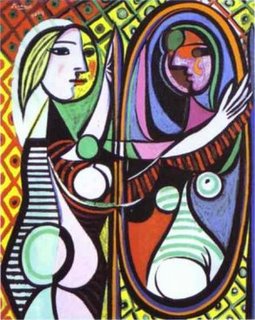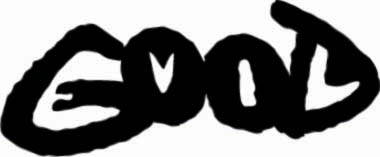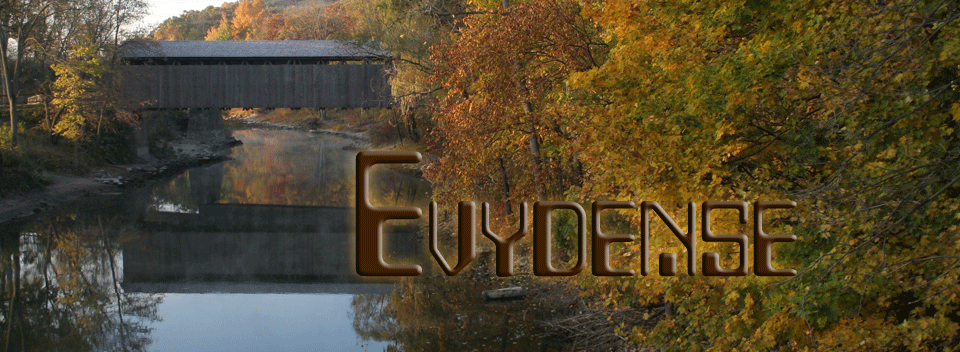Of Mirrors, Randomness, Balance and Infinity
The introduction: by way of "the Quotes"
"It is known that there are an infinte number of worlds, simply because there is an infinite amount of space for them to be in. However, not every one of them is inhabited. Any finite number divided by infinity is as near nothing as makes no odds, so the average population of all the planets in the Universe can be said to be zero. From this it follows that the population of the whole Universe is also zero, and that any people you may meet from time to time are merely products of a deranged imagination." - Douglas Adams
Douglas Adams is author of "Hitchhikers Guide To The Galaxy" and "So Long And Thanks For All The Fish", two of my all-time favorites. There are moments when I believe that there exist the equivalent of different models of the human brain. I like to think that his and mine come from a similar engineering pool. In the quote above, he actually makes an interesting case for "infinity around the edges", that space where most physicists and mathematicians write off aberrations as 'noise', and then either round up or down for convenience. In doing so, they could eliminate an entire universe full of beings. Last week, in their podcast discussion, Dave and Jay were exploring whether the conscious mind is 'thin' or 'rich'. I wondered in an e-mail to them why a choice had to be made at all. Why could it not be "some like it hot, some like it cold", and be nothing more than a personal thought-organizing structure. I also questioned if that was possible, might it also be possible that a person with a thin consciousness would be incapable of comprehending that there could be another kind, and vice versa. It's a variation of the old question "Do you see 'red' the way I do?" It appears that science in particular is always seeking a single-sided answer to everything, and my proposition is that every single-sided answer simultaneously must have its antithetical solution. "Between thesis and antithesis, lies synthesis."
"To see a world in a grain of sand and heaven in a wild flower
Hold infinity in the palms of your hand and eternity in an hour." - William Blake
In this reference, Blake reflects on the poetic essence of both Chaos Theory, with the world being reflected in a grain of sand, as well as 'is', with a grain of sand being able to re-generate itself, no matter whether in the physical world (sand) or some esoteric, intangible dimension (time). I have come to believe that seeing such linkages is not the default vision for most people, for it is, on the surface at least, counter-intuitive to logic, and therefore must be 'wrong'. It is only wrong, however, if a logical order is the only order that is permitted to be attended to, and that would be an illogical conclusion. Randomness, for instance, is an example which invalidates the assumptive of logic, exclusive to all else.
"You use a glass mirror to see your face; you use works of art to see your soul." George Bernard Shaw
....and what greater work of art is there than a soul's face, seen through its eyes? So far, I've been keeping my discussions within the boundaries of fairly safe territory, in that I've been examining the physical world, and playing around the edges of the mental one. There is, in my system however, a third area that is compatible with all I've said already, and that is the area we refer to as the soul, or spirit, or essence of an entity. The pattern of three is paramount again. As I pointed out yesterday, I will always use intent that is non-judgemental, but is discriminatory. 'is'-LANGUAGE will be used to distinguish, not to judge.
"Friends are the mirror, reflecting the truth of who we are" -anon
....or, at least, the truth of who they see that we are, for who can see the true inner us but ourself? Again, I use this quote not only to reflect on the value of mirror imagery, but to serve as a segue to a gentle transition towards an alternate level of discussion/existence.
(Note: This painting by Picasso is titled "Girl Before Mirror")
I need to borrow your imagination for awhile ... that's the part of your power that lets you pretend things to be that aren't, or make things do that don't ... stuff like that. I'd like you to imagine that you exist in a balanced state, or universe, and have just picked up a handful representing 'all the white'. Now it's examination time, with a multiple choice question:
What do you think you'd have to have in your other hand to maintain a state of balance?
a) Another handful of 'all the white'?
b) A handful of 'all the black'?
c) A handful of 'all the nothing'?
d) A handful of 'all the not white'?
e) none of the above?
Answer a) gives you balance with itself (the cloned version of 'white' that it has the capacity to produce in 'is'), but your universe will be out of balance because it now has twice the amount of white it had before, when you put 'all the white' into your hand. And where did this extra 'white' come from, if you had 'all the white' in your hand in the first place? A mirror image does not replicate existence, it merely reflects it.
Answer b) gives you balance with itself (the opposite version of 'white' that it has the capacity to produce in 'is'). The absence of 'white' is 'black', and since you've selected 'all the white' already, you've created an additional amount of 'all the black' equivalent to 'all the white' that you removed. Now there's a great deal less 'white' than 'black', because you've added the new 'all the black' to whatever 'black' existed initially. Therefore, there's no balance at all. So if it was in balance before the selection, it can't be afterwards.
Answer c) gives you balance with itself (the absence version of 'white' that it has the capacity to produce in 'is'), but the state of existence of what remains is now out of balance, because it has 'all the white' removed from it, which was needed for the original balanced state, from when you gathered and picked up all the 'white' in the first place, so you have balanced nothing against it.
Answer d) gives you balance with itself (suggesting a variation of the absence version of 'white' (let's call it the exclusion version for the moment) that it by definition creates)...if you've selected 'all the white', then everything that is left over contains the subset of 'all that is not white', and if only that subset were to be chosen for balance, what remains would be unbalanced. This is the closest of the first four possibilities, and on the surface seems to be the correct choice. It excludes the consideration, however, of 'all that is both white and not white', and so assumes that there is the same amount of 'all the white' as there is of 'all the not white'. This is a false assumption. (Note: in 'is' however, NOT-WHITE would include everything that is not WHITE....it is, by definition, the pure complement to WHITE).
So, the answer would be e), the other choices all being subsets of it. The option that is missing to maintain balance, or equilibrium, is 'all the everything else'. That was what kept the universe in balance before we removed the handful of 'all the white', so it must be what still is required to maintain the same balance afterwards. Yet, in some sense, all the other choices also make a case for balance. Actually, if you examine them closely, they all make a case for 'altered balance', or 'changed balance', governed by the laws that any system when disturbed seeks a level of equilibrium. The first four cases represent possible final states that could be reached if a state of {dis-equilibrium, turmoil, chaos, turbulence....} is passed through....in other words, if a threshold is crossed.
When you examine this illustration, do you see evil within good, or good containing evil? Or both.
Are they mirrored reflections of each other, one being unable to exist without the other being present. If one disppears, does the other?, Is that a true mirror image? If a mirror image disappears, the original entity still remains. But if the original entity still remains, has the mirror image actually disappeared, or has the mirror simply been removed? In other words, if a tree falls in a forest....
Again, it is the {dichotomy, the complement, the image ...} that defines the original, but it is the original that creates its {antithesis, opposite, clone....}
Let's re-word the multiple-choice problem slightly, and put it in 'is'-LANGUAGE.
Assuming you had just picked up a handful, representing WHITE, what would you have in your other hand to maintain a state of balance?
The answer can only be, as stated above, NOT-WHITE. If you start out with a complete chocolate bunny rabbit, and eat some of it, the entity in its wholeness can only be described as {RABBIT....NOT-RABBIT}, regardless of how much has been eaten, and how much remains. Furthermore, these two dots, lie side-by-side in existence, separated (or joined) only by 'is'.
It's probably about this time when you're scratching your mental head and asking, "So...what's the connection with the blog title?" It relates back to the discoveries uncovered in the past few decades during the evolution of Chaos Theory.
I'll be linking several discoveries together.
"Douady and Hubbard used a brilliant chain of new mathematics to prove that every floating molecule [in a fractal image produced from a Mandlebrot Set] does indeed hang on a filagree that binds it to all the rest. ....The mathematics proved that any segment --- no matter where, and no matter how small --- would, when blown up by the computer microscope, reveal new molecules, each resembling the main set and yet not quite the same....a miracle of miniaturization in which every new detail was sure to be a universe of its own, diverse and entire" (Gleick, p 228-9)
Diverse and entire. In a generalized and universal model of 'everything', I suggest that the filagree threads binding them together are 'is', as in the broken circle analogy.
This is completely compatible with the declaration in 'is' that there is one and only one existence of everything (never put into those exact words before: the earlier wording has been said as "everything and everybody is totally unique". In fact, that is the single most critical underpinning of 'is', and is the concept represented by the symbol of 'is' itself, explained in this blog entry).
"In a structured subject, it is known what is known, what is unknown, what people have already tried and doesn't lead anywhere. There you have to work on a problem which is known to be a problem, otherwise you get lost. But a problem which is known to be a problem must be hard, otherwise it would already have been solved." (Peitgen, quoted by Gleick p. 230)
Personally, I was astounded when I read this statement. It reminded me of the famous quote by the head of the U.S. Patent Office in the late 1800's who recommended to the government that the patent office be shut down, "because everything of any import has been invented by now." Peitgen was in fact making a case for the unstructured and free-wheeling nature of the study of complexity within the realm of the unfolding literature and research surrounding Chaos. He redeemed himself, I felt, when on the next page he was quoted as saying "But you can look at situations that can be understood partially now and with rigor perhaps in future generations".
That is how I think about 'is'. I know what I know. My instincts all tell me that there is substance of some manner to it, but I have yet to find an audience or synthesize the essence satisfactorily yet for it to be taken as a serious consideration. I am not deterred; rather, as I said a week or so ago, I am, quite the contrary, emboldened. That is the case because the more I read and research, the more are the patterns which I perceive as they solidify, take shape, form and meaning, not in a concrete sense but an abstract one. Therein lies my difficulty.
We are so used to representing everything in our physical world that to take anything outside that realm appears to diminish it by the very act of its disposition. That's why I had you take a 'handful of all the white' at the beginning of this thoughtline. (P.S. You can put it down now, we're through with the experiment!)
"The boundary is where a Mandlebrot set program spends most of its time, and makes all of its compromises... The boundary is where points are slowest to escape the pull of the set. It is as if they are balanced between competing attractors, one at zero and the other, in effect, ringing the set at a distance of infinity...The boundary between two or more attractors in a dynamical system served as a threshold of a kind that seems to govern so many ordinary processes, from the breaking of materials to the making of decisions" (ibid, p232) [Note: a future blog entry will address Koch's curve, and the idea expressed in this quote of a balance between zero and infintiy].
This is the part that excites my theory. Even the same terminology (threshold) is used to describe the boundary, or the area of turbulence..the area I have described as the 'is' moment. It is the line that separates {ANYTHING...NOT-ANYTHING}.
"Scientists studying fractal basin boundaries [thresholds] showed that the border between calm and catastrophe could be far more complex than anyone had ever dreamed." (ibid, p235)
It goes on to have a discussion about the role randomness plays in Nature, if any. Hubbard, who dedicated his life to finding the patterns of the Mandlebrot set in magnified scales of representation, insisted "Everything is highly structured. In biology, randomness is death, chaos is death". Perhaps that may be true, but I must wonder if partial death, or that particular death, is simply a part of a necessary order at a different level of the scale? For how can you rule out the observable, simply to justify the expectations of your belief?
Once more, the significant difference between 'is' and any other scientific knowledge base, is that science always only deals with subsets. Even if 'new' discoveries are made, they are not universal, nor are they discoveries in the sense that they didn't already exist but we simply didn't know of them or their behaviours. Even though they 'add on' to an existing understanding, they actually only unveil an existing state to the level of human awareness. Beyond all that, encompassing all that, and subordinate to all that, there surely must be a 'final gestalt', a continuous 'is' moment, a moment when everything is coincident, co-existent and co-aware.
He [Hubbard] further emphatically declares, "the Mandlebrot set obeys an extraordinarily precise scheme leaving nothing to chance whatsoever" (ibid. p.239). Again, I question the definitiveness of the declaration (but certainly not its accuracy). He himself pointed out that the set only emerges with magnification into a random, chaotic system at the basin threshold. It seems to presume that chaos as a function of chaos is at best problematic, and at worst incomplete. In either case, it seems to deny chaos as a component of chaos altogether. By so doing, he has, it appears, only moved the same problem one level deeper without addressing the issue of chaos itself.
I believe that there is an order to randomness. It is the order of being unordered, and must exist for order to exist. A complete system consists of a partial component of it, and the complement of that partial component. Randomness is the complement to order. If order were to be reflected in a mirror at the threshold of an ordered system, all that would be reflected back would be the randomness of 'the other side of the mirror', where the mirror represents the chaotic divide separating order (calm) from disorder (randomness).
Any system seeks equilibrium, even a random system. Any intuitive thought seeks its counter-intuitive counterpart. They can't exist one without the other. Duality of existence is the only model of existence that can both contain itself and not contain itself, and we know that both exist. That is the essence of 'is'. Further, it can (and must) use itself to not only prove itself, but prove all else, true or otherwise.
That sounds like a lot of quaint, cute doublespeak. It a sense is. It has to be. The only existence that doesn't have it's NOT-EXISTENCE is the seed of existence itself. And it has the POTENTIAL for both. And so we have discovered the beginning of infinity, the mirror of existence, the randomness of path, and the duality of balance.
We have discovered the meaning of the title.
We have discovered 'is'. Learning is reflected in teaching. Teaching is reflected in learning.
Learning is reflected in teaching. Teaching is reflected in learning.
"I've learned that the important thing is not what others think of me, but what I think of me" - Age 38
PEACE












Whoaaa! THat good/evil thing was cool! At first I only saw good, then after looking at it longer I saw evil....
Posted by KSHIPPYCHIC |
1:59 p.m.
KSHIPPYCHIC |
1:59 p.m.
I seen GOOD too....then after I read further I seen the evil part. Hope that is a good sign?!:)
Posted by Mackey |
9:42 p.m.
Mackey |
9:42 p.m.
Post a Comment